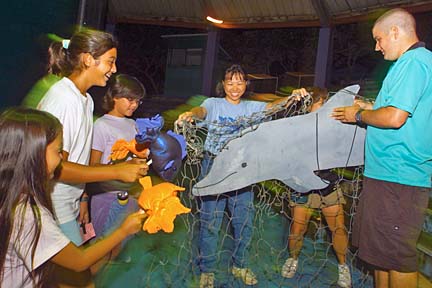

|
‘Doze with the Dolphins’
educational for
young and old
Kamalii bobbed up and down behind the glass. The 546-pound, 34-year-old dolphin was examining us, as if we were part of a human exhibit meant to entertain him. We had set up camp next to the dolphin pool in Sea Life Park for its "Doze with the Dolphins" program. A few members of the group set up tents in the meadow or opted to sleep next to the reef tank.
|
The evening is an educational experience for parents as well as wee ones, and begins with an interactive skit that demonstrates the effect of marine debris on sea animals. The keiki act as seabirds and fish using props to save a dolphin from a bad guy with a net.
After that, the crowd sang some reworked lyrics to the 1961 song "The Lion Sleeps Tonight": "In the ocean, the mighty ocean, the dolphin sleeps tonight ..."
Dr. Nocturnal, portrayed by camp leader Brian Boltz, taught the children about sleeping patterns of different sea creatures. The yellow tang, he explained, is a daytime fish with small eyes and big body as bright as a neon sign. "Bright colors make it hard to hide at night, so they mute their colors," he said, adding the puffer fish also has a camouflage mechanism that lets it blend in with its environment.
As the kids eagerly searched for the animals using their flashlights, 9-year-old Jolie Au got a kick out of seeing the cowry shell at night and the muted tang.
The group also learned how sea turtles lay their eggs at night due to the lower risk of predators finding their nest. For the same reason, their hatchlings also leave the nest at night. "They use the moonlight to help guide them to the ocean," said Boltz.
Science was a subject that brought laughter from the youngsters when Boltz talked about the physiology of the parrotfish. "He eats coral and it comes out the other end," said Boltz. "Lots of sand is parrotfish poop."
Meanwhile, adults appreciated the secure location. "We don't need to worry about the kids," said Waltz.

|
Girl Scout leader Laurie Narahara's 9-year-old daughter, Marci, said that they felt "squished" sleeping on the park's benches, but it had one advantage in helping them to avoid encounters with any creepy-crawly critters that are inevitable in the open air.
Nevertheless, the experience of camping led to a few cases of excitement-induced insomnia. "We stayed up all night. ... We couldn't fall asleep," said 9-year-old Anela Ling.
"Anela was so excited about the dolphin show the next day, she wouldn't let anyone sleep," said 10-year-old Kelsie Komatsu, adding more to the story.
Ten-year-old Taylor Shreve said she could hear the dolphins "talking" through the night. "It was interesting to watch them sleep," she said. "They sink to the bottom and rest."
Joseph Meno later took on the role of Dr. Bottlenose, teaching the group about the dolphin's anatomy and characteristics. "They swim about 25 miles per hour, about the same speed as a mo-ped," he said. In comparison, the speedy penguin can swim 35 miles per hour.
Sleep turns out to be very different for them compared with land mammals. There is plenty of time for a dolphin to catch a catnap between trips to the water's surface, but this isn't a viable option, explained Meno. "They are very complex animals," he said.
 |
Because they need to remain consciously breathing, they let one-half of the brain sleep at a time. "They sleep with one eye open and one eye shut," he added. The practice allows the animal to gets the rest it needs, but it is never completely unconscious.
"I do that sometimes," announced one of the dads in the crowd.
PARK DOLPHINS receive many perks including back rubs, praise, toys, fish and an abundance of attention. "Every dolphin has its own personality, just like people. Some are more playful than others," Meno said.
The park is relatively peaceful at night. "Sometimes something will startle the sea lions, and they go off making lots of noise," Waltz said.
In the morning, everyone had a chance to feed the sea lions and sea turtles.
"When turtles eat their food, water comes out of their nose, like a water gun," said Meno, who offered other bits of information, such as how penguins waterproof by keeping their feathers well oiled.
By the end of the evening, new friends had been made.
"The dolphins are so friendly. I have a much greater appreciation for them," said Patti Au, another Girl Scout leader who is an advocate of such extracurricular, experience-building excursions. "The children really remember what they learn when it's not being taught in the classroom."
www.sealifeparkhawaii.com/

Click for online
calendars and events.